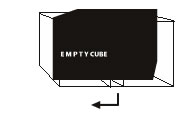JULIÃO SARMENTO
APRIL 10, 2012

CONTACTS
jsarm@mail.telepac.pt
EXHIBITION INFORMATION
SELF PORTRAIT
The other as self-portrait.
‘We are in a memory chamber 1 . This brief sentence by James Lingwood offers us a vantage point that allows us to put Julião Sarmento’s work into perspective; that is to say, to achieve a perception of an artistic practice that has diverse and prolific ways of finding and selecting the means (approaches) and references used and developed in his works, thus producing an increasingly more complex and contradictory vocabulary, which systematically challenges our visual and intimate memories.
The project he has created for this edition of EMPTY CUBE, ‘Auto-retrato / Self Portrait,’ explores that complexity by activating methods and protocols that lead us to re-evaluate the status of the image of the work of art in its historical correlations, until the present time.
Julião Sarmento has chosen a work of art, one that is both representative and symbolic of the painting collection of the most important museum belonging to the Portuguese state, the National Museum of Ancient Art (Lisbon), to be briefly displayed in a space and a project that are notable for their ephemerality. At first glance, this action recontextualises the museum and the museological approaches of the entities involved, while accepting the established conventions on which their patrimonial vocation is based. Every necessary procedure has been respected – a thorough insurance policy was contracted from an international company specialised in insuring works of art, and specialised transportation was procured – as befits the temporary loan of a work of art for the purpose of an exhibition, with every prescription and condition fulfilled.
The chosen piece, ‘Portrait of Lucas Vosterman, the Elder,’ an oil on canvas by Anton Van Dyck (c. 1630), depicts a man closely linked to the artistic craft, being himself an artist (engraver), as well as a friend of the painter. The picture shows a resolute face that looks towards us and intersects our space, confronting us.
The practice of painting has been constantly explored in Sarmento’s work, alongside other techniques and media. However, the presence of an identifiable face is something that is largely connected to his video and photographic work. Faces rarely appear in his paintings with the intention of depicting a person in particular: they are almost unrecognisable and carnally connected to the body, or else are simply vestigial in a body that raises its neck as a mute limb, with the absent face as a metamorphosis of the imagined.
The presence of this portrait, isolated inside the cubic space installed within the gallery, heightens the image’s potency and brings into the equation the portrait as metaphor of the presence of the other as its double, in the sense that this double is determined by the portrait as a painting genre and by appropriation as an approach that allows visitors, during the brief moments accorded to them, the possibility of recognising the portrayed author within a historical lineage of artists’ acts and determinations.
João Silvério
April 2012







